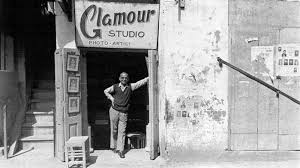Vertically Arranged Photo Wonderland - David MacDougall: Photo Wallahs
Judith and David MacDougall's Photo Wallahs highlighted nicely the differences between visual cultures. Even though, they seemed to focus on the photographic traditions of Mussoorie, the undercurrent of their project was to examine Western visual culture as well (in this they do not stand alone, most anthropological works implicitly or explicitly want to offer an insight into the anthropologist's own society through the study of the 'Other').
The MacDougalls created a really thorough overview of the photographic 'hierarchy' of the town with its artists, craftsmen and mass producers. Their film made it clear that no image can 'make sense' outside of its context, the seemingly peculiar methods and photographic approaches actually fit into a hierarchy. In their film the MacDougalls let their informants explain the 'meanings' of the images and their practices, they tried to avoid forcing their anthropological interpretations on them (it is interesting to see how different their authorial voice is in the article connected to the film, titled Photo Hierarchicus). The film was also a nice document of how the former colonized people can appropriate and transform a medium that was introduced by the colonizers and was used to categorize and monitor them. The Indian photographers seemed to be 'fluent' in several visual cultures/languages: some of them worked in the Western tradition (e.g. the street photographers who take photos for official documents or the 'photo artists'/studio photographers who follow the Western aristocratic visual aesthetic) and some used the tropes of Indian religious and mythological imagery, and others mixed the two.
It was also interesting to see how certain attitudes towards photography are shared among different visual regimes. The MacDougalls emphasized that poorer people in the rural area preferred a certain studio photographer who did not force middle-class conventions and behaviors on them during the photo shoot. They wanted control over their image and they wanted to be recorded according to their own terms. It reminded me of the anxiety over the control of one's likeness in the European visual regime which was attempted to be eased by the GDPR regulations - people are anxious about how their photos would be used, how long they are stored etc. MacDougall also pointed out that in the praxis of the Indian 'photo artists' the ideal and the apparent is mixed and their 'slow' method became more valued as mass photographers appeared on the streets. In the Western visual regime 'truthfulness' seem to be valued more in photography (this kind of heavy, painted retouch would be considered tasteless or 'fake'). However, if one thinks of the carefully timed and staged photos posted by Instagram influencers, the same approach can be recognized: the ideal and the apparent is mixed in a way that one enhances the other, traces of retouching are evident but kept at a level where it is still acceptable (or even desirable) for the viewers.
One of my classmates in the Visual Anthropology class very insightfully applied Roland Barthes' concepts that he developed in Camera Lucida. She pointed out that in the MacDougalls' Photo Wallahs we can identify the tripartite relationship but it is being doubled: the operator is dual (MacDougall and the portrayed photographers), the spectators are both the audience of the film and the customers and the spectrum is the relationship between the portrayed photographers and their subjects. I believe we can also discover equivalents of Barthes' two key concepts, the studium and the punctum. As the MacDougalls explores the multilayered social connotations of photography in Mussoorie, we can identify the studium (the majority of the film is about the unpacking of this visual regime that is in many respects alien to Western photographic traditions, but is also intertwined and influenced by it through colonialism). The punctum can be small but powerful instants of visuality that captures the viewer and evokes idiosyncratic feelings in them (like the ghastly qualities of Mr. Sharma's frontal, static portraits of couples).
After watching the MacDougalls' film my question is if we can find general, shared traits and practices within different visual cultures. From example, with the proliferation of photos and the democratization of photographic techniques will the artistic approach in photography become more valued?




Megjegyzések
Megjegyzés küldése